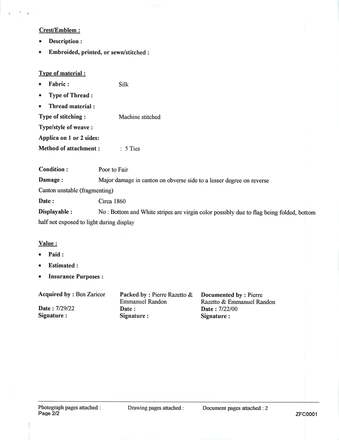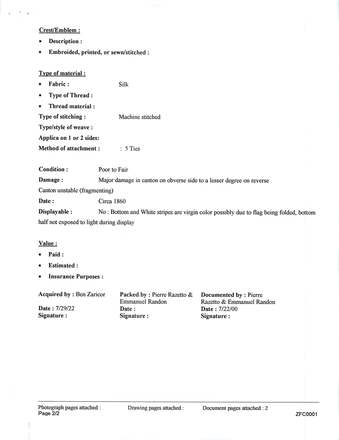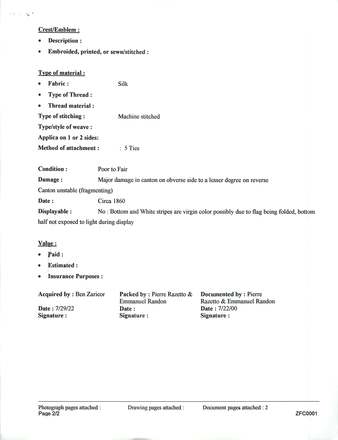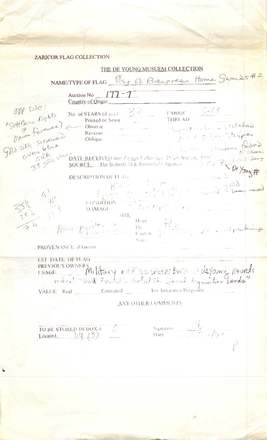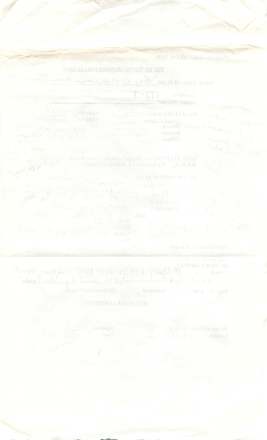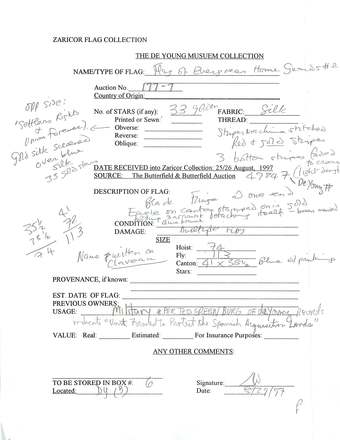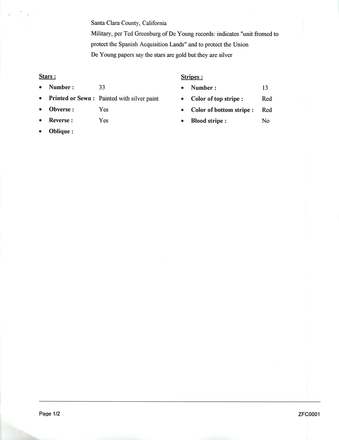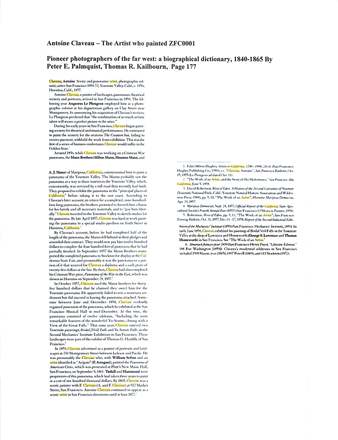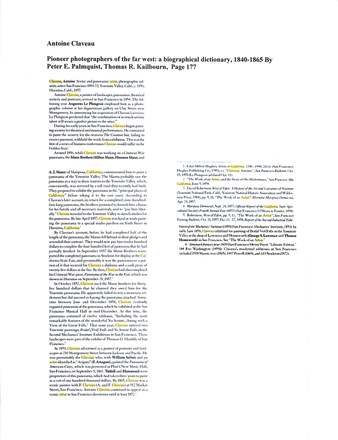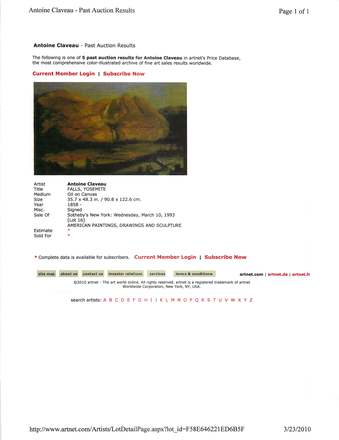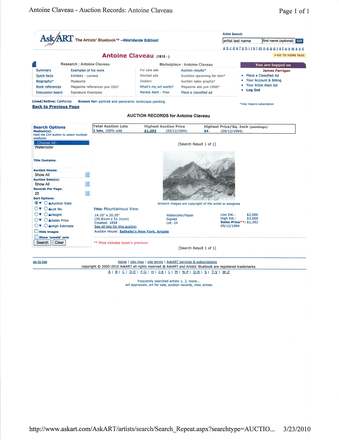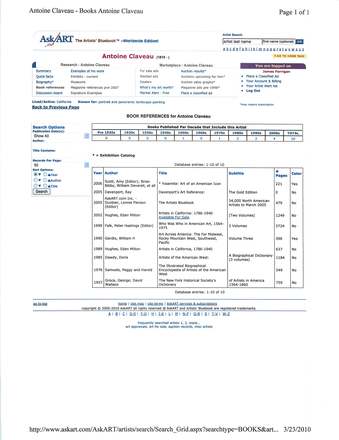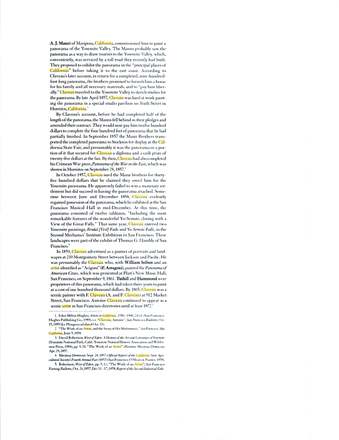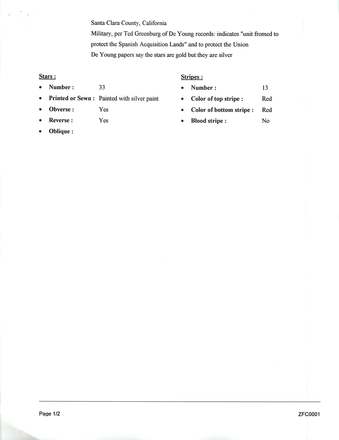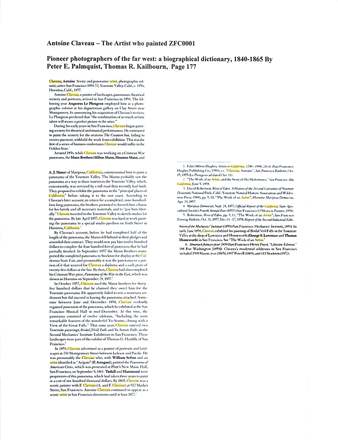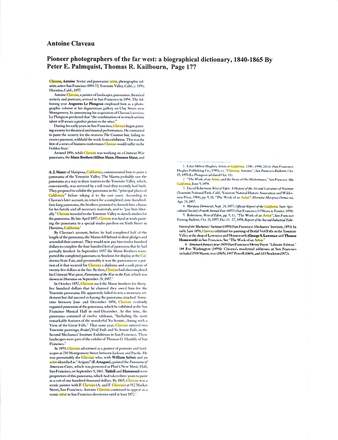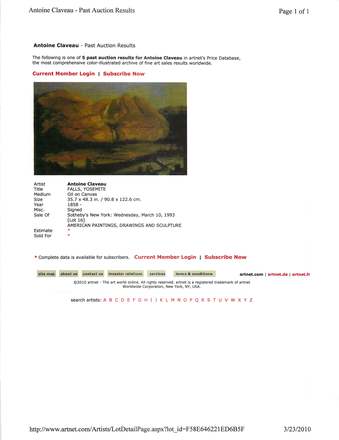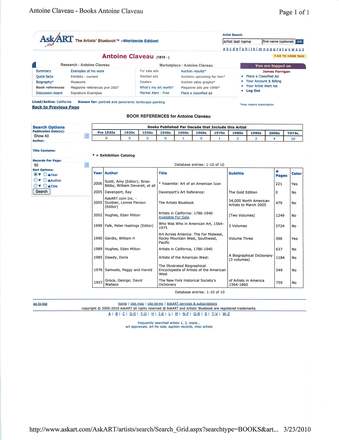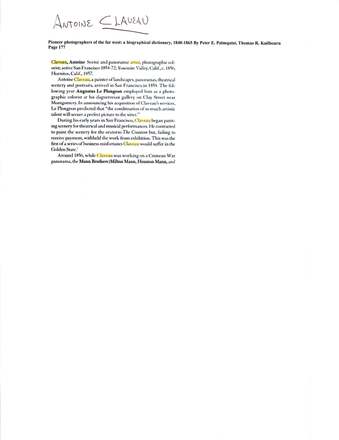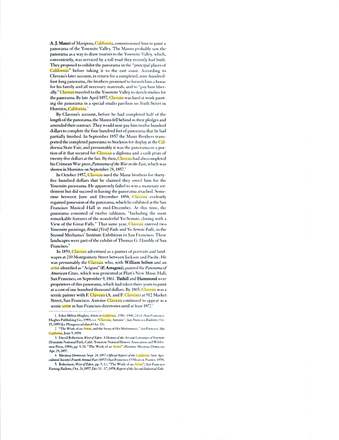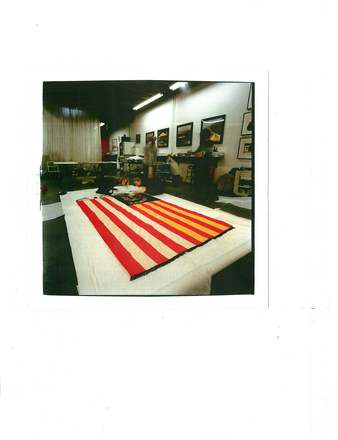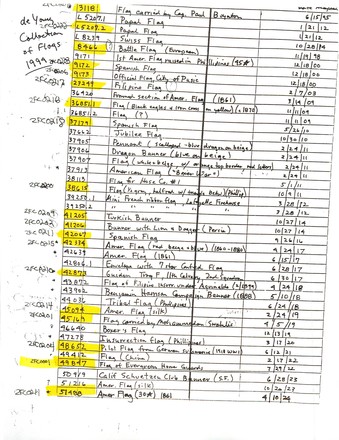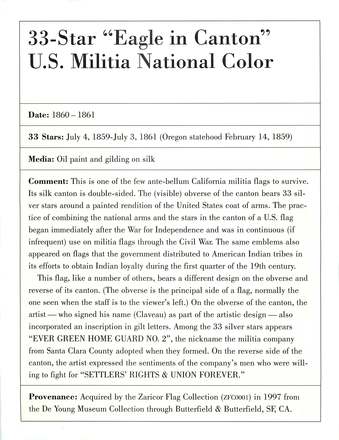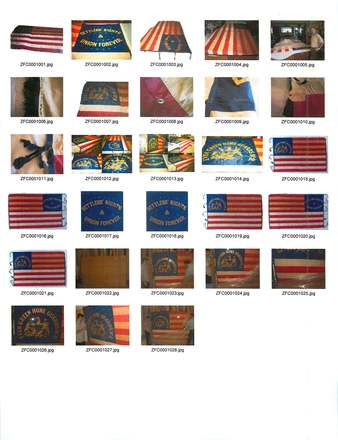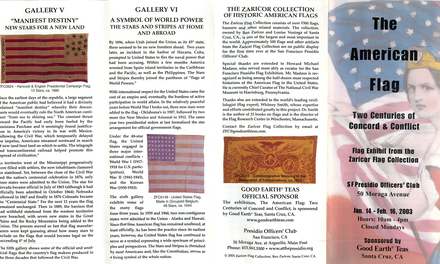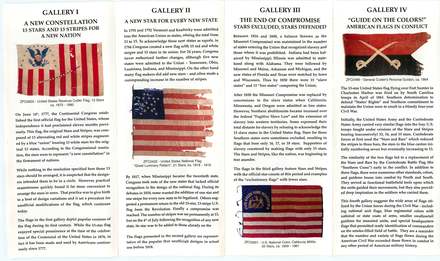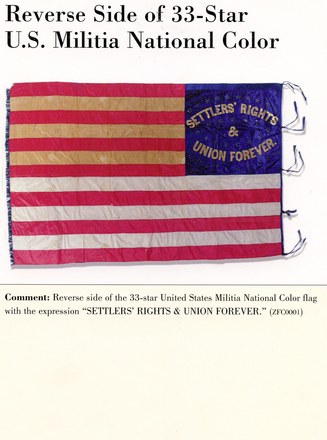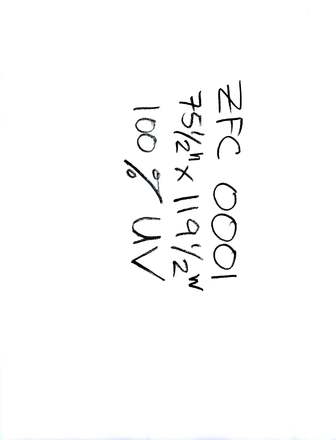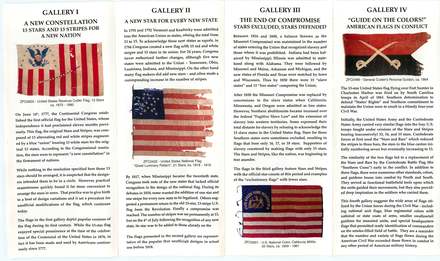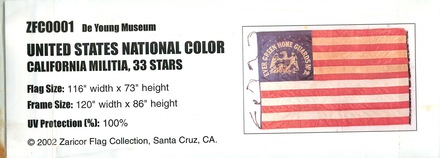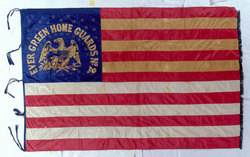

Obverse
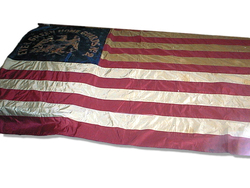
Obverse
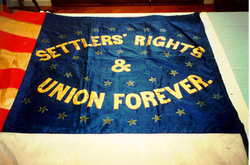
REVERSE CANTON
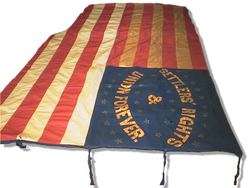
Reverse
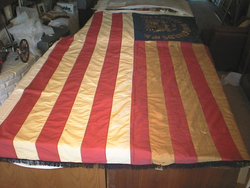
Obverse 2
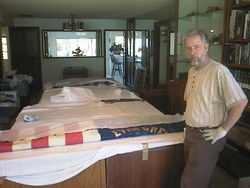
Flag & Ben
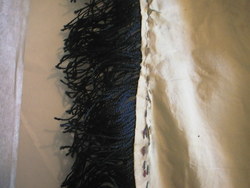
Fringe

Obverse Canton
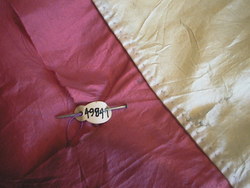
Obverse Tag
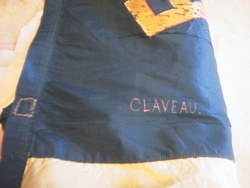
Reverse Detail
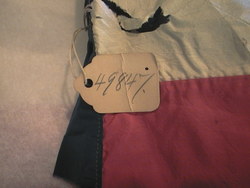
Tag
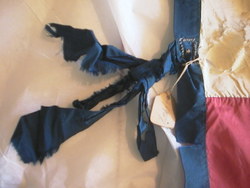
Tie
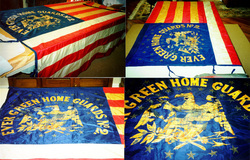


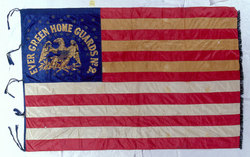
Obverse Horizontal Flag
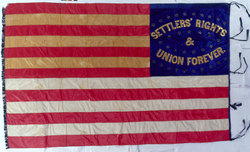
Reverse Horizontal Flag

Reverse - Detail
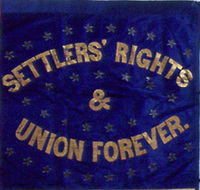
Book Photo

Book Photo
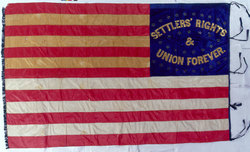
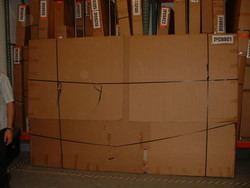
Storage Carton
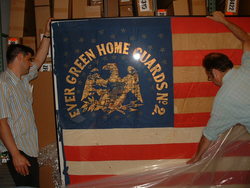
In Frame
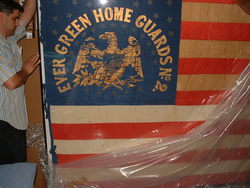
In Frame - 2
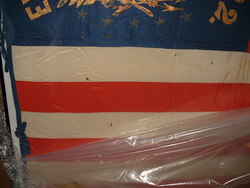
Detail
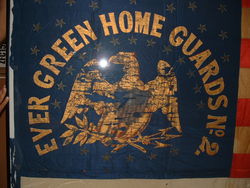
Canton Detail

Canton Oblique
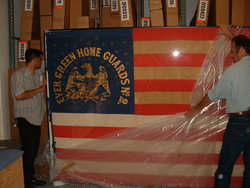
Repacking
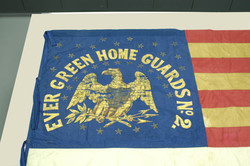
Framing Option - Beige

Framing Option - Blue
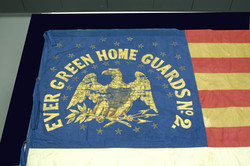
Framing Options - Navy


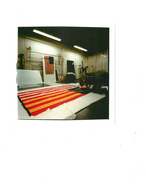

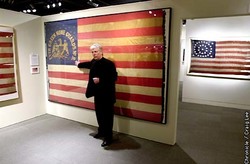
SF Chronicle photo by CRAIG LEE

Squatters declaration of Rights

Acquisition Photo

Acquisition Photo

Acquisition Photo

Acquisition Photo

Acquisition Photo

Acquisition Photo

Acquisition Photo

Acquisition Photo

Acquisition Photo

Acquisition Photo

Acquisition Photo

Acquisition Photo

Acquisition Photo
U.S. 33 Star "Eagle Canton" Militia National Color
Sub-collection: de Young Museum33 Star "Eagle Canton", US Militia National Color, Evergreen Home Guard.
33 Star "Eagle Canton", US Militia National Color, Evergreen Home Guard.
One of the few ante-bellum California militia flags to survive. Its silk canton is double-sided. The (visible) obverse of the canton bears 33 silver stars around a painted rendition of the United States coat of arms. The practice of combining the national arms and the stars in the canton of a U.S. flag began immediately after the War for Independence and were in continuous (if infrequent) use on militia flags through the Civil War. The same emblems also appeared on flags that the government distributed to American Indian tribes in its efforts to obtain Indian loyalty during the first quarter of the 19th century.
This flag, like many others, bears a different design on the obverse and reverse of its canton. (The obverse is the principal side of a flag, normally the one seen when the staff is to the viewers left.) On the obverse of the canton, the artist - who signed his name "Claveau" (Antoine Claveau) as part of the artistic design - also incorporated an inscription in gilt letters. Among the 33 silver stars appears EVER GREEN HOME GUARD NO. 2, the unit designation for militia company from Santa Clara County adopted when they formed. On the reverse side of the canton, the artist expressed the sentiments of the company's men who were willing to fight for SETTLERS RIGHTS & UNION FOREVER. The Stars and Stripes forms the basic design; a distinctive canton differing in design on each side represents the unit that carried the flag. Adaptation of the national flag to serve as a flag for an individual organization was a common theme in American history.
The Evergreen Home Guard was one of the militia units that participated in the so-called "Settlers War" of 1861. In the spring of 1861 settlers in the Evergreen Valley - or squatters, as they were called - made their voices heard by publishing a "Squatters Declaration of Rights" and distributing copies through-out Santa Clara Valley. The landowner, Antonio Chabolla, a native Californio, who held a patented Mexican land grant, asked the Americans to leave. The squatters refused and armed themselves. Chaoblla's lawyer obtained writs of eviction which were to be served by the sheriff.
On the morning of 9 April 1861, three days before the firing at Fort Sumter, a crowd of several hundred had gathered in downtown San Jose. Many in the crowd had been present earlier in front of city hall, when Sheriff John Murphy gave a roll call for a posse to enforce the eviction writ. The crowd responded that they would not assist the sheriff who then dismissed them.
According to the journalist Alf Doten, the crowd dispersed and reassembled some 6 miles away at the "Seat of the War", at the Evergreen School House, near the Chabolla Ranch. The squatter/settler army had grown to over 2,000 men, all mounted and armed, including a band, several cannon, several flags and this "Stars & Stripes." Besides the Evergreen Home Guard No. 2, the squatter army included The Berryessa Home Guards and Santa Clara Home Guards. They all agreed to defy the writ and an "Ambrotype Man" recorded the scene while the farmers waved other banners bearing oaths such as "Resistance to Fraud is Obedience to God" and "The Welfare of the People is the Supreme Law of God." There was no violence, bloodshed, and at approximately 1:00 P.M. the settlers returned to their homes, and the Squatter Army returned to San Jose, demonstrating loudly that they meant business! Doten described that besides the horsemen, there were many buggies and large wagons and the flags were all carried on the wagons for the return to San Jose.
The crowd now returned to the streets of San Jose. Sheriff Murphy drove his buggy into the center of Washington Square (now the site of San Jose State), and surrounded by all, gave a speech. He said he derived his power from the people, but the people had resisted him. The people had taken his power away, what could he do? If they were right, go ahead, but if they were wrong, he wasn't responsible. He was cheered, and the crowd dispersed peacefully; thus ended the "Settlers War," three days before the firing at Fort Sumter.
The firing on Ft. Sumter by Confederate forces was unfortunate for the Settlers, for their resistance to the legally elected service was tantamount to insurrection now being carried out on the East Coast. Apparently some in California referred to the Settlers as secessionists.
To dispel this notion, this flag was designed and painted and presented to the Settlers on 30 April 1860 in San Jose California. On 1 May 1861, The Daily Alta California, Volume 13, Number 4093, page 1, reported, "Presentation of a Flag.
The Settlers of Evergreen District. No. 2, met yesterday morning at Evergreen School-house, when they were presented with an American flag. The flag is of silk, six feet by ten, made in a very handsome manner. The blue field contains thirty-four stars, and on one side of the field is an American eagle bearing the escutcheon of the Union around which, in gold letters, reads " Evergreen Home Guards, No. 2," on the opposite side, amidst the stars, is 'Settlers' Rights and Union forever." This national ensign is the best reproof to those who have designedly set the report afloat that the Settlers are Secessionists. The flag was brought on the field in a wagon, and was presented by Miss O. V. Cottrell, In a very neat and patriotic address. It was received by Mr. W. C. Spencer, who responded very feelingly. After the presentation. It was resolved to attend the picnic, on Wednesday, at McCartysville, to be attended by the band of music, etc., and the banner and flag to be borne in procession."
It is presumed that the Evergreen Home Guards continued to use this color during the Civil War. The militias that were formed to defend the land grants made under Spanish & Mexican rule, but they also acted in defense of the Union at the time of the Civil War, relieving regulars for service ion the East. The dark blue fringe (hand-sewn only at the fly end) is unusual; it may originally have been black and it might have been added as a symbol of mourning after the time of construction or added at a later date. Because of the star count this flag would have been made circa in 186 before the 34th star was added on July 4th. It is unknown if the design was inspired by any flags carried during the Settlers War.
The Stars and Stripes forms the basic design; a distinctive canton differing in design on each side represents the unit that carried the flag. Adaptation of the national flag to serve as a flag for an individual organization is a common theme in American history.
This flag is a striking example of mid-19th century workmanship; and likely one of the oldest surviving United States Flags made in California. This 33-star American flag from 1860 in good condition; discoloration of top three white stripes to yellow other white stripes lower section remain virgin white due to no exposure to light. The fabric is silk; gold and silver paint used on canton; machine-stitched.
Exhibition History:
De Young Museum, Flag Room, Golden Gate Park, San Francisco, CA.
First Presidio Exhibit
33-Star Eagle In Canton U.S. Militia National Color
Second Presidio Exhibit, 2003 Gallery III
33-Star Eagle in Canton U.S. Militia National Color
Publication History:
Madaus, Howard M., Dr, Whitney Smith, The American Flag: Two Centuries of Concord and Conflict. Santa Cruz: VZ Publications, 2006, pp. 64-65.
Provenance:
• Studio of Antoine Claveau, San Francisco, CA, 1858/59.
• Evergreen Hone Guard #2, San Jose, CA, 1859/61.
• Retained as a memento of service by Capt. William Spencer.
• Conveyed to Dr. Angus B. Cowan, Fresno, CA.
• Gifted by Dr. Angus B. Cowan to the deYoung Museum, San Francisco, CA, 29 July 1922.
• Sold via Butterfield & Butterfield Auctions, SF, CA, to the Zaricor Flag Collection, 1997.
ZFC Significant Flag
Item is Framed
Sources:
Madaus, Howard M.- Whitney Smith, The American Flag: Two Centuries of Concord and Conflict, VZ Publications, Santa Cruz, 2006.
Showdown in Washington Square: The San Jose Settlers War of 1861, San Jose Public Library, 2 November 2011, from:
http://www.sjpl.org/blog/showdown-washington-square-san-jose-settlers-war-1861
Clark, Walter Van Tilburg, The Journals of Alfred Doten, Volume One, April 9, 1861, Reno, University of Nevada Press, 1973.
Cortese, Colleen, Squatters Declaration of Rights led to Squatters War of 1861, January 14, 2005 Paths to Evergreen, Evergreen Times, 2 November 2011, from: http://www.evergreentimes.com/011405/paths2evg.htm
Martucci, David, The Eagle Standard, US Flags, Part 4, 2 November 2011, from: http://www.midcoast.com/~martucci/flags/us-hist5.html
Eagle in Canton Flag, 2 November 2011, from: http://americanhistory.si.edu/militaryhistory/collection/object.asp?ID=241
200 years of Old Glory, 16 January 2003, SFGate.com, 2 November 2011, from: http://articles.sfgate.com/2003-01-16/bay-area/17472159_1_flags-silicon-valley-ben-zaricor
Antoine Claveau, AskART, 2 November 2011, from: http://www.askart.com/askart/c/antoine_claveau/antoine_claveau.aspx
Scott, Amy, editor, Yosemite: Art of an American Icon, Los Angeles, University of California Press and Autry National Center Museum of the American West, 2006.
Palmquist, Peter E. & Thomas R. Kailbourn, Pioneer Photographers of the Far West: A Biographical Dictionary, 1840-1865, Stanford, Stanford University Press, 2000.
"Presentation of a Flag." Daily Alta California, Volume 13, Number 4093, 1 May 1861
Image Credits:
Zaricor Flag Collection
San Francisco Chronicle
CSG
MLC
Hoist & Fly | |
|---|---|
| Width of Hoist | 76 |
| Length of Fly | 115 |
Union/Canton | |
|---|---|
| Width of Union/Canton | 38 |
| Length of Union/Canton | 38 |
Stars | |
|---|---|
| Size of Stars | 2 |
Stripes | |
|---|---|
| Width of 1st Stripe | 6 |
| Width of 3rd Stripe | 6 |
| Width of 8th Stripe | 6 |
| Width of Last Stripe | 6 |
| Size of Hoist | 1 |
Frame | |
|---|---|
| Is it framed? | yes |
| Frame Height | 86 |
| Frame Length | 120 |
Stars | |
|---|---|
| Number of Stars | 33 |
| How are the stars embeded? | Painted |
| Are there stars on obverse? | no |
| Are there stars on reverse? | no |
| Star Pattern | scatter pattern |
Stripes | |
|---|---|
| Number of Stripes | 13 |
| Color of Top Stripe | Red |
| Color of Bottom Stripe | Red |
| Has a Blood Stripe? | no |
| Comments on Stripes | Stripes have discolored from previous exhibition |
Crest/Emblem | |
|---|---|
| Description of Crest/Emblem | Stylized American Eagle |
Nationality | |
|---|---|
| Nation Represented | United States |
Fabric | |
|---|---|
| Fabric | Silk |
| Comments on Fabric | Silk is dehydrated and subject to fracture |
Stitching | |
|---|---|
| Stitching | Machine |
| Comments on Stitching | Fringe hand stitched |
Thread | |
|---|---|
| Type of Thread | Needs Analysis |
| Thread Material | Needs Analysis |
Weave | |
|---|---|
| Type of Weave | Plain |
Attachment | |
|---|---|
| Comments on Method of Attachmen | 5 Ties |
| Method of Attachment | Ties |
Applica | |
|---|---|
| Applique Sides | Double Faced = Reads correctly on both sides |
Documentation | |
|---|---|
| Documents | |
| Research Documents | |
| Public Copy & Signs | |
Condition | |
|---|---|
| Condition | Fair |
| Damage | in good condition; discoloration of top three white stripes to yellow, other white stripes lower section remain virgin white due to no exposure to light. Major damage in canton on obverse side to a lesser degree on reverse Canton unstable (fragmenting) Trending to fair |
| Displayable | yes |
Date | |
|---|---|
| Date | 1858 |
Exhibits | |
|---|---|
| Exhibition Copy | Exhibited in the Flag Room of the de Young Museum, San Francisco, CA. First Presidio Exhibit (ZFC0001) 33-STAR "EAGLE IN CANTON" U.S. MILITIA NATIONAL COLOR Date: 1860-1861 Media: Oil paint and gilding on silk Comment: This is one of the few ante-bellum California militia flags to survive. Its silk canton is double-sided. The (visible) obverse of the canton bears 33 silver stars around a painted rendition of the United States coat of arms. The practice of combining the national arms and the stars in the canton of a U.S. flag began immediately after the War for Independence and was in continuous (if infrequent) use on militia flags through the Civil War. The same emblems also appeared on flags that the government distributed to American Indian tribes in its efforts to obtain Indian loyalty during the first quarter of the 19th century. This flag, like a number of others, bears a different design on the obverse and reverse of its canton. (The obverse is the principal side of a flag, normally the one seen when the staff is to the viewer's left.) On the obverse of the canton, the artist - who signed his name (Claveau ) as part of the artistic design - also incorporated an inscription in gilt letters. Among the 33 silver stars appears EVER GREEN HOME GUARD NO. 2, the nickname the militia company from Santa Clara County adopted when they formed. On the reverse side of the canton, the artist expressed the sentiments of the company's men who were willing to fight for SETTLERS' RIGHTS & UNION FOREVER. Provenance: Acquired by the Zaricor Flag Collection (ZFC0001) in 1997 from the De Young Museum Collection through Butterfield & Butterfield Auction House of San Francisco, CA. Second Presidio Exhibit, 2003 - GALLERY III (ZFC0001) 33-Star "Eagle in Canton" U.S. Militia National Color Date: 1860-1861 33 Stars: July 4, 1859-July 3, 1861 (Oregon statehood February 14, 1859) Media: Oil paint and gilding on silk Comment: This is one of the few ante-bellum California militia flags to survive. Its silk canton is double-sided. The (visible) obverse of the canton bears 33 silver stars around a painted rendition of the United States coat of arms. The practice of combining the national arms and the stars in the canton of a U.S. flag began immediately after the War for Independence and was in continuous (if infrequent) use on militia flags through the Civil War. The same emblems also appeared on flags that the government distributed to American Indian tribes in its efforts to obtain Indian loyalty during the first quarter of the 19th century. This flag, like a number of others, bears a different design on the obverse and reverse of its canton. (The obverse is the principal side of a flag, normally the one seen when the staff is to the viewer's left.) On the obverse of the canton, the artist-who signed his name (Claveau) as part of the artistic design-also incorporated an inscription in gilt letters. Among the 33 silver stars appears "EVER GREEN HOME GUARD NO. 2", the nickname the militia company from Santa Clara County adopted when they formed. On the reverse side of the canton, the artist expressed the sentiments of the company's men who were willing to fight for "SETTLERS' RIGHTS & UNION FOREVER." Provenance: Acquired by the Zaricor Flag Collection (ZFC0001) in 1997 from the De Young Museum Collection through Butterfield & Butterfield, SF, CA. |
Publications | |
|---|---|
| Publication Copy | Madaus, Howard M., Dr, Whitney Smith, The American Flag: Two Centuries of Concord and Conflict. Santa Cruz: VZ Publications, 2006, pp. 64-65. "33-Star "Eagle in Canton" U.S. Militia National Color This is one of the few ante-bellum California militia flags to survive. Its silk canton is double-sided. The canton bears 33 silver stars-the only one in the exhibition-around a painted rendition of the United States coat of arms. The practice of combining the national arms and the stars in the canton of a U.S. flag began immediately after the War for Independence and was in continuous, if infrequent, use on militia flags through the Civil War. The same emblems also appeared on flags that the government distributed to Native American Indian tribes in its efforts to obtain Native American Indian loyalty during the first quarter of the 19th century. This flag, like a number of others, bears a different design on the obverse and reverse of its canton. The obverse is the principal side of a flag, normally the one seen when the staff is to the viewer's left. On the obverse of the canton, the artist, who signed his name "Claveau" as part of the artistic design, also incorporated an inscription in gilt letters. Among the 33 silver stars appears "Ever Green Home Guards No. 2," the nickname the militia company from Santa Clara County, called today Silicon Valley, adopted when they were formed. On the reverse side of the canton, the artist expressed the sentiments of the company's men who were willing to fight for "Settlers' Rights & Union Forever." Date: 1860 - 1861 Size: 76" hoist x 115" fly 33 Stars: July 4, 1859 - July 3, 1861 (Oregon statehood February 14, 1859) Media: Oil paint and gilding on silk Provenance: Acquired by the Zaricor Flag Collection in 1997 from the De Young Museum San Francisco CA Collection through Butterfield & Butterfield, SF, CA. ZFC0001" |


